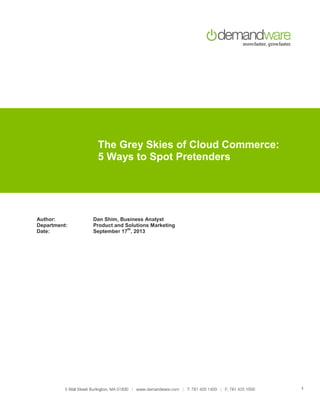Cloud providers vs Cloud pretenders
- 1. The Grey Skies of Cloud Commerce: 5 Ways to Spot Pretenders Author: Department: Date: Dan Shim, Business Analyst Product and Solutions Marketing th September 17 , 2013 1
- 2. Cloud delivery models come in different colors. While various shades may look similar, the reality is that genuine Software as a Service (SaaS) in the cloud is fundamentally different from licensed software hosted by Managed Service Providers. And in the fast-moving world of digital commerce, there’s a clear competitive advantage that genuine SaaS in the cloud brings to high-growth retailers. The following five commercial and architectural facts separate true cloud providers from cloud pretenders. 1. Is it necessary to purchase hardware or software? Cloud Provider: Access to the platform is available via the web with no upfront capital to procure software, hardware or infrastructure licenses. Cloud Pretenders: Software licenses must be procured and hosted by dedicated set of servers. Cloud pretenders offer a method of paying for the software in recurring installments – these installments give you access to a single distinct and isolated version of the software license and limited amount of capacity which is hosted in a data center. In the event a user decides to shift the hosted application on-site, a license repurchase is often required for the relocation. 2. How are upgrades implemented into the platform? Cloud Provider: Platform and feature upgrades are seamlessly introduced into the user environment and are readily available at the next logon. These enhancements are released several times per year, so users take advantage of continual innovation to stay ahead of consumer demands. Cloud Pretenders: Software version upgrades are not automatically pushed out. Updates and upgrades are optional to the application owner and generally entail incremental charges, costly migration projects and business disruption, including downtime. Integrations to third-parties -- based on the technical, architectural and functional updates -- often require extensive rework and QA to ensure compatibility and performance. 3. Is there a need to forecast peak capacity loads and purchase hardware and software to meet that peak capacity? Cloud Providers: Providing on-demand and elastic scalability is a core attribute of true cloud applications and estimating capacity is not required. 2
- 3. Cloud Pretenders: Managed Service Providers (MSP) providing hosting services for licensed software generally charge a fixed and recurring hosting fee based on forecasted capacity requirements and in the case of unanticipated capacity needs, additional infrastructure must be procured along with new payment terms and conditions. After the capacity is procured it often takes time to introduce the capacity into the environment. 4. Are users accessing different versions of the application? Cloud Providers: The architecture of a genuine cloud model ensures that all users access the latest version of the application every time they log on. Cloud Pretenders: Hosted applications are generally a single instance of software operated and managed independently from user to user. Consequently, the version of the software varies across each client depending on the date of adoption, upgrades purchased, and incremental modules procured. 5. How easily are third-party applications integrated into to my website? Cloud Providers: Users can configure, customize and develop unique designs, functionality, and user experiences without the concern of ensuring compatibility with future platform upgrades or scalability of infrastructure. Cloud Pretenders: New customizations and functionality enhancements on hosted software require modifications to the base code that preclude the ability to upgrade effectively in the future. Additional performance evaluations, scalability testing, quality assurance, and prolonged downtime may be required. 3



